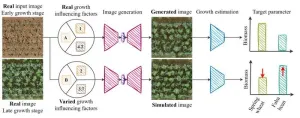(Press-News.org) Embargoed for release until 5:00 p.m. ET on Monday 17 June 2024
Annals of Internal Medicine Tip Sheet
@Annalsofim
Below please find summaries of new articles that will be published in the next issue of Annals of Internal Medicine. The summaries are not intended to substitute for the full articles as a source of information. This information is under strict embargo and by taking it into possession, media representatives are committing to the terms of the embargo not only on their own behalf, but also on behalf of the organization they represent.
----------------------------
1. Paternal use of metformin during sperm production not associated with major birth defects
Authors caution that familial risk profile, lifestyle factors may play a role
Abstract: https://www.acpjournals.org/doi/10.7326/M23-1405
Editorial: https://www.acpjournals.org/doi/10.7326/M24-0883
URL goes live when the embargo lifts
A study of almost 400,000 live births found that paternal use of metformin monotherapy was not associated with major congenital malformations (MCMs) in newborns. Associations between metformin in polytherapy and birth defects could potentially be explained by worse underlying parental cardiometabolic risk profile of those taking multiple diabetes medications. The study is published in Annals of Internal Medicine.
Researchers from Harvard T.H. Chan School of Public Health, Kahn-Sagol-Maccabi (KSM) Research and Innovation Institute, and Brigham and Women's Hospital studied data from a large Israeli health fund from 1999 to 2020 to assess the potential adverse intergenerational effect of metformin use during the sperm production period preceding conception. MCMs and parental cardiometabolic conditions were ascertained using clinical diagnoses, medication dispensing information, and laboratory test results. Although crude findings suggested that metformin was associated with increased risk of MCM (6.2% versus 4.7% when father used no diabetic medication), this association did not persist with adjustment for paternal cardiovascular and metabolic co-morbid conditions and exclusion of children born to mothers with diabetes or hyperglycemia (to eliminate possible effects mediated through the mother). Fathers prescribed metformin and other diabetic medication were more likely to be older, with co-existent cardiovascular and metabolic conditions, to be smokers and to have fertility problems. Similarly, mothers were more likely to have cardiovascular co-morbidity and to have experienced fertility problems when the father used metformin.
The author of an accompanying editorial from the University of Dundee suggests that these findings underscore the importance of considering paternal health in the context of reproductive planning and prenatal care. The author notes that metformin is a safe and effective treatment option for type 2 diabetes for men and women trying to conceive as well as for managing hyperglycemia in pregnant women in the first trimester. As such, it may be time to reconsider current prenatal care guidelines that advocate switching to insulin therapy for those trying to conceive.
Media contacts: For an embargoed PDF, please contact Angela Collom at acollom@acponline.org. To speak with the corresponding author, please contact Ran S. Rotem, SM, ScD, at ran.rotem@mail.harvard.edu.
----------------------------
2. Continuing metformin during first trimester does not increase risk for major malformations
Abstract: https://www.acpjournals.org/doi/10.7326/M23-2038
URL goes live when the embargo lifts
A study of more than 12,000 pregnant women with type 2 diabetes receiving metformin monotherapy before conception found that compared with switching to insulin monotherapy, continuing metformin and adding insulin in early pregnancy resulted in little to no increased risk for major malformations in the infant. The analysis is published in Annals of Internal Medicine.
Researchers from Harvard T.H. Chan School of Public Health use real-world data from the U.S. Medicaid health care administration database from 2000 to 2018 to evaluate the teratogenicity of metformin use in the first trimester of pregnancy. Women taking metformin were either switched to insulin monotherapy or prescribed insulin in addition to metformin within 90 days of last menstrual period (LMP). Outcomes considered were non-chromosomal fetal malformations and non-live births, comprised of spontaneous abortion, termination and stillbirth. The estimated risk for non-live birth was 32.7% under insulin monotherapy and 34.3% under insulin plus metformin. The authors also found that the estimated risk for live birth with congenital malformations was 8.0% under insulin monotherapy and 5.7% under insulin plus metformin. Based on these findings, current recommendations that suggest switching from metformin to insulin before pregnancy for fetal safety concerns may require reconsideration.
Media contacts: For an embargoed PDF, please contact Angela Collom at acollom@acponline.org. To speak with the corresponding author, Yu-Han Chiu, MD, ScD, please contact Jack MacDonald at jmacdonald@hsph.harvard.edu.
----------------------------
3. Diet quality remains poor among socioeconomically disadvantaged populations
Abstract: https://www.acpjournals.org/doi/10.7326/M24-0190
URL goes live when the embargo lifts
A study of U.S. dietary trends found that diet quality among U.S. adults improved modestly between 1999 and 2020, but the proportion of socioeconomically disadvantaged people with poor diet quality remained high, and dietary disparities persisted or worsened. The report is published in Annals of Internal Medicine.
Researchers from the Department of Population Science and Policy at Icahn School of Medicine at Mount Sinai and the Food is Medicine Institute at the Friedman School of Nutrition Science and Policy at Tufts University studied data from 51,703 adults responding to the National Health and Nutrition Examination Survey (NHANES) to evaluate trends in diet quality by race, ethnicity, and socioeconomic disadvantage. Participants' diet quality was assessed using the American Heart Association (AHA) 2020 continuous diet score, which is measured based on a higher intake of healthy, unprocessed foods, and a lower intake of sugar, sodium, and processed foods. They also looked at energy-adjusted consumption of the diet components and other individual food groups and nutrients. Poor diet was defined as less than 40% adherence to the AHA score, intermediate as 40% to 79.9% adherence, and ideal as at least 80% adherence. The researchers found that from 1999 to 2020, the proportion of U.S. adults with poor diet quality decreased by more than 11%, the proportion with intermediate quality increased by more than 10%, and the proportion with ideal quality increased slightly. However, worsening disparities in diet quality remained among those in disadvantaged socioeconomic groups. The proportion of adults with poor diet quality decreased from 47.9% to 33.0% among those with food security but did not change among those experiencing food insecurity.
Media contacts: For an embargoed PDF, please contact Angela Collom at acollom@acponline.org. To speak to the corresponding author, please contact Taraneh Pettinato at Taraneh.Pettinato@tufts.edu.
----------------------------
4. Scoping review identifies factors taxing physicians' attention
Abstract: https://www.acpjournals.org/doi/10.7326/M23-3229
Editorial: https://www.acpjournals.org/doi/10.7326/M24-0880
URL goes live when the embargo lifts
Researchers from the University of Colorado Anschutz Medical Campus systematically reviewed 6,448 studies to identify and characterize the literature on clinician attention, compile the metrics used to measure attention, and create a framework of key concepts related to clinician attention. The findings are published in Annals of Internal Medicine.
The authors defined attention as a state of presence, focus, and selective incorporation of information within clinical environments. The concept of an "ecology of attention" was used to describe an analogous interrelationship between clinician attention and the clinical environment, suggesting key measurable factors that influence the ability of clinicians to maintain presence and focus. Of the studies reviewed, 585 met inclusion criteria. About 80% were descriptive, and 20% were investigational. More studies (66%) focused on barriers to clinician attention than on facilitators of attention. A 6-category framework was derived to organize the literature that included definitions of attention; evaluation of the clinical environment's effect on attention; personal factors affecting attention; relationships between interventions and factors that affect attention and patient outcomes; the effect of clinical alarms and alarm fatigue on attention; and the effect of health information technology on attention. The authors believe the findings from their scoping review and the analytic framework will help researchers or quality improvement experts studying or looking to improve the “ecology of attention.”
The authors of an accompanying editorial from Stanford University School of Medicine say that clinician attention should be spent in the right places. Incremental initiatives intended to enhance safety may not work if they overwhelm working memory and take attention away from other important activities, especially considering that the complexity of daily work for most health care professionals now exceeds human beings' finite cognitive load capacity. The authors suggest that adoption of human factors and ergonomics principles can help the health care delivery system address this issue and enable the provision of high-quality, compassionate, and cost-effective care in a sustainable manner.
Media contacts: For an embargoed PDF, please contact Angela Collom at acollom@acponline.org. To speak with the corresponding author, please contact Kelsey Hussey at KELSEY.HUSSEY@CUANSCHUTZ.EDU.
END
Paternal use of metformin during sperm production not associated with major birth defects
Authors caution that familial risk profile, lifestyle factors may play a role
2024-06-17
ELSE PRESS RELEASES FROM THIS DATE:
American diets have a long way to go to achieve health equity
2024-06-17
Poor diet continues to take a toll on American adults. It’s a major risk factor for obesity, type 2 diabetes, cardiovascular disease, and certain cancers, and more than one million Americans die every year from diet-related diseases, according to the Food and Drug Administration. Poor diet and food insecurity is also costly, attributing to an estimated $1.1 trillion in healthcare expenditures and lost productivity. These burdens also contribute to major health disparities by income, education, zip code, race, and ethnicity.
In a study from the Food is Medicine Institute at the Friedman School of Nutrition Science and Policy at Tufts University published today in ...
New ‘aging atlas’ provides a detailed map of how cells and tissues age
2024-06-17
A new aging atlas gives scientists an in-depth view of how individual cells and tissues in worms age and how different lifespan-extending strategies might stop the clock.
Aging impacts all the tissues in our body – from our muscles to our skin. Figuring out how individual tissues and cells age could help researchers better understand the aging process and aid in the development of anti-aging treatments.
Due to their short lifespans, simple body plans, and genetic similarity to humans, many researchers study aging in roundworms. To look at aging at the level of tissues and cells, a team of researchers from HHMI's Janelia ...
New technology allows researchers to precisely, flexibly modulate brain
2024-06-17
By Beth Miller
Human brain diseases, such as Parkinson’s disease, involve damage in more than one region of the brain, requiring technology that could precisely and flexibly address all affected regions simultaneously. Researchers at Washington University in St. Louis have developed a noninvasive technology combining a holographic acoustic device with genetic engineering that allows them to precisely target affected neurons in the brain, creating the potential to precisely modulate selected cell ...
Origins of cumulative culture in human evolution
2024-06-17
Each of us individually is the accumulated product of thousands of generations that have come before us in an unbroken line. Our culture and technology today are also the result of thousands of years of accumulated and remixed cultural knowledge.
But when did our earliest ancestors begin to make connections and start to build on the knowledge of others, setting us apart from other primates? Cumulative culture — the accumulation of technological modifications and improvements over generations — allowed humans to adapt to a diversity of environments and challenges. But, it is unclear when cumulative culture first developed during hominin evolution.
A study published ...
Mitophagy and cancer: BNIP3/BNIP3L’s role in stemness, ATP production, proliferation, and cell migration
2024-06-17
“[...] our current work has provided a novel strategy to enrich for a sub-population of cancer cells, with high basal levels of mitophagy.”
BUFFALO, NY- June 17, 2024 – A new research paper was published on the cover of Aging (listed by MEDLINE/PubMed as "Aging (Albany NY)" and "Aging-US" by Web of Science) Volume 16, Issue 11, entitled, “Mitophagy and cancer: role of BNIP3/BNIP3L as energetic drivers of stemness features, ATP production, proliferation, and cell migration.”
Mitophagy is a selective form of autophagy which permits ...
Breakthrough approach enables bidirectional BCI functionality
2024-06-17
Brain-computer interfaces or BCIs hold immense potential for individuals with a wide range of neurological conditions, but the road to implementation is long and nuanced for both the invasive and noninvasive versions of the technology. Bin He of Carnegie Mellon University is highly driven to improve noninvasive BCIs, and his lab uses an innovative electroencephalogram (EEG) wearable to push the boundaries of what’s possible. For the first time on record, the group successfully integrated a novel focused ultrasound stimulation to realize bidirectional BCI that both encodes and decodes brain waves using machine learning in a study with 25 human subjects. This work opens ...
Polarization and risk perception could play important roles in climate-policy outcomes
2024-06-17
Times of crises often call for strong and rapid action, but in polarized societies, strong top-down policies can backfire.
In a paper published on June 17, 2024, in Environmental Research Letters, SFI Applied Complexity Fellow Saverio Perri, SFI Science Board Fellow Simon Levin (Princeton University), and colleagues present a conceptual model of how these dynamics could play out in efforts to decarbonize our energy supply. The model illustrates the complex interplay between strong policies, people’s perception of risk, and the amount of polarization in a society. They show that in situations where the perception of risk is low — where the ...
AI shows how field crops develop
2024-06-17
Researchers at the University of Bonn have developed software that can simulate the growth of field crops. To do this, they fed thousands of photos from field experiments into a learning algorithm. This enabled the algorithm to learn how to visualize the future development of cultivated plants based on a single initial image. Using the images created during this process, parameters such as leaf area or yield can be estimated accurately. The results have been published in the journal Plant Methods.
Which plants should I combine ...
African research funders in global spotlight through Dimensions indexing project
2024-06-17
African research is receiving a major visibility boost with the indexing of 10 national funders in Dimensions, the world’s largest linked research database.
This project is a collaboration with Digital Science, the Africa PID Alliance (APA), the Association of African Universities (AAU), the Training Centre in Communication (TCC Africa), and the Research Organization Registry (ROR).
“This project connects the research outputs from leading African funding bodies to the global research ecosystem,” said Joy Owango, Executive Director of TCC Africa ...
New study suggests cancer drug could be used to target protein connection that spurs Parkinson’s disease
2024-06-17
FOR IMMEDIATE RELEASE
In studies with genetically engineered mice, Johns Hopkins Medicine researchers say they have identified a potentially new biological target involving Aplp1, a cell surface protein that drives the spread of Parkinson’s disease-causing alpha-synuclein.
The findings, published May 31 in Nature Communications, reveal how Aplp1 connects with Lag3, another cell surface receptor, in a key part of a process that helps spread harmful alpha-synuclein proteins to brain cells. Those protein buildups are hallmarks of Parkinson’s disease.
Notably, the researchers say, Lag3 is already the target of a combination ...
LAST 30 PRESS RELEASES:
Mount Sinai Health system receives $8.5 million NIH grant renewal to advance research on long-term outcomes in children with congenital heart disease
Researchers develop treatment for advanced prostate cancer that could eliminate severe side effects
Keck Medicine of USC names Christian Pass chief financial officer
Inflatable fabric robotic arm picks apples
MD Anderson and SOPHiA GENETICS announce strategic collaboration to accelerate AI-driven precision oncology
Oil residues can travel over 5,000 miles on ocean debris, study finds
Korea University researchers discover that cholesterol-lowering drug can overcome chemotherapy resistance in triple-negative breast cancer
Ushikuvirus: A newly discovered giant virus may offer clues to the origin of life
Boosting the cell’s own cleanup
Movement matters: Light activity led to better survival in diabetes, heart, kidney disease
Method developed to identify best treatment combinations for glioblastoma based on unique cellular targets
Self-guided behavioral app helps children with epilepsy sleep earlier
Higher consumption of food preservatives is associated with an increased risk of type 2 diabetes
NTU Singapore-led team captures first-ever ‘twitch’ of the eye’s night-vision cells as they detect light, paving the way for earlier detection of blindness-causing diseases
Global aviation emissions could be halved through maximising efficiency gains, new study shows
Fewer layovers, better-connected airports, more firm growth
Exposure to natural light improves metabolic health
As we age, immune cells protect the spinal cord
New expert guidance urges caution before surgery for patients with treatment-resistant constipation
Solar hydrogen can now be produced efficiently without the scarce metal platinum
Sleeping in on weekends may help boost teens’ mental health
Study: Teens use cellphones for an hour a day at school
After more than two years of war, Palestinian children are hungry, denied education and “like the living dead”
The untold story of life with Prader-Willi syndrome - according to the siblings who live it
How the parasite that ‘gave up sex’ found more hosts – and why its victory won’t last
When is it time to jump? The boiling frog problem of AI use in physics education
Twitter data reveals partisan divide in understanding why pollen season's getting worse
AI is quick but risky for updating old software
Revolutionizing biosecurity: new multi-omics framework to transform invasive species management
From ancient herb to modern medicine: new review unveils the multi-targeted healing potential of Borago officinalis
[Press-News.org] Paternal use of metformin during sperm production not associated with major birth defectsAuthors caution that familial risk profile, lifestyle factors may play a role





